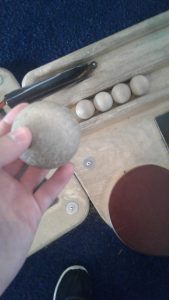At the museum, I watched a 3-4 year old boy play with a multiple ball Rube Goldberg machine while an older parent or guardian watched. I was on the second floor, in the nursery, and all of the surrounding exhibits were very simple tactile-focused machines that children could interact with to make something unexpected or interesting happen. The strengths of this particular exhibit fall into three main categories. First, the hands-on, moving-parts nature of the machine. Second, the unambiguous open design where children could see and interact with the balls as they fell through the machine. Finally, the imperfect nature of the exhibit which allowed children to create and ‘fix’ jams when the balls would stop rolling.
Here is a quick video of the exhibit:
The thing that first catches a child’s attention, is the tactile balls that can be sent down the machine in interesting ways. Here is one of those balls:

When placed in the top of the machine, they fall through and make noise as the hit different parts of the exhibit. It’s eye catching and interesting, since it doesn’t always move in expected ways and doubles back on itself before it reaches the floor. The boy that I watched love to run around the machine, seeming to almost race the balls around the machine. He would wait at the end, putting his hands in front of the final shoot, so that he could quickly place the balls back in the top, keeping the machine constantly in motion.
The second main positive of this machine is the simple, open nature of it. As seen in the video, the balls are never hidden, go out of sight, or become unable to be interacted with. At any point a child could stop the ball, push it backwards, insert a new ball, etc. The made it interesting to watch, and also allowed the child to interact with the balls in different ways. It helped engender a sense of curiosity, especially when it made unexpected dinging sounds when hitting a metal piece, and gave the child further agency to inspect and understand the exhibit.
The final, and in my opinion most important, part of the exhibit was the ability for the boy to ‘fix’ jams in the machine. If balls were place to quickly into the machine, or in different places in the machine, or sometimes for seemingly no reason at all, they would knock against one another and stop moving. This was easily the most exciting part of the exhibit and the boy, somewhat counter-intuitively, loved that part. In fact, when he noticed me watching, he proudly proclaimed that he knew “just what to do” and “likes it when it jams” because it let him run around and problem solve. It made the child feel smart, inspired additional curiosity, and pushed him to understand and inspect the machine even further. Incredibly, the imperfection of the exhibit was its best attribute.
The most frustrating part of the exhibit, however, was the guardian watching the child. At first, she was absent dealing with another child, but after having noticed me watching her child, she moved closer (undoubtedly to watch over both me and the boy). Once she arrived, though, she began explaining to the boy how he could avoid jams and what he was doing wrong with the balls. In fact, when he began to push balls up the machine backward, she sharply reprimanded him. Saying “that’s not how it works. That’s not how it was meant to be used.” I would argue, however, that there is no ‘right’ way for it to be used. The child was exploring and being curious, but the parent was stifling that reaction. Ultimately, the strongest aspect of this exhibit are its ability to be experimented and played with.
Leave a Reply
You must be logged in to post a comment.